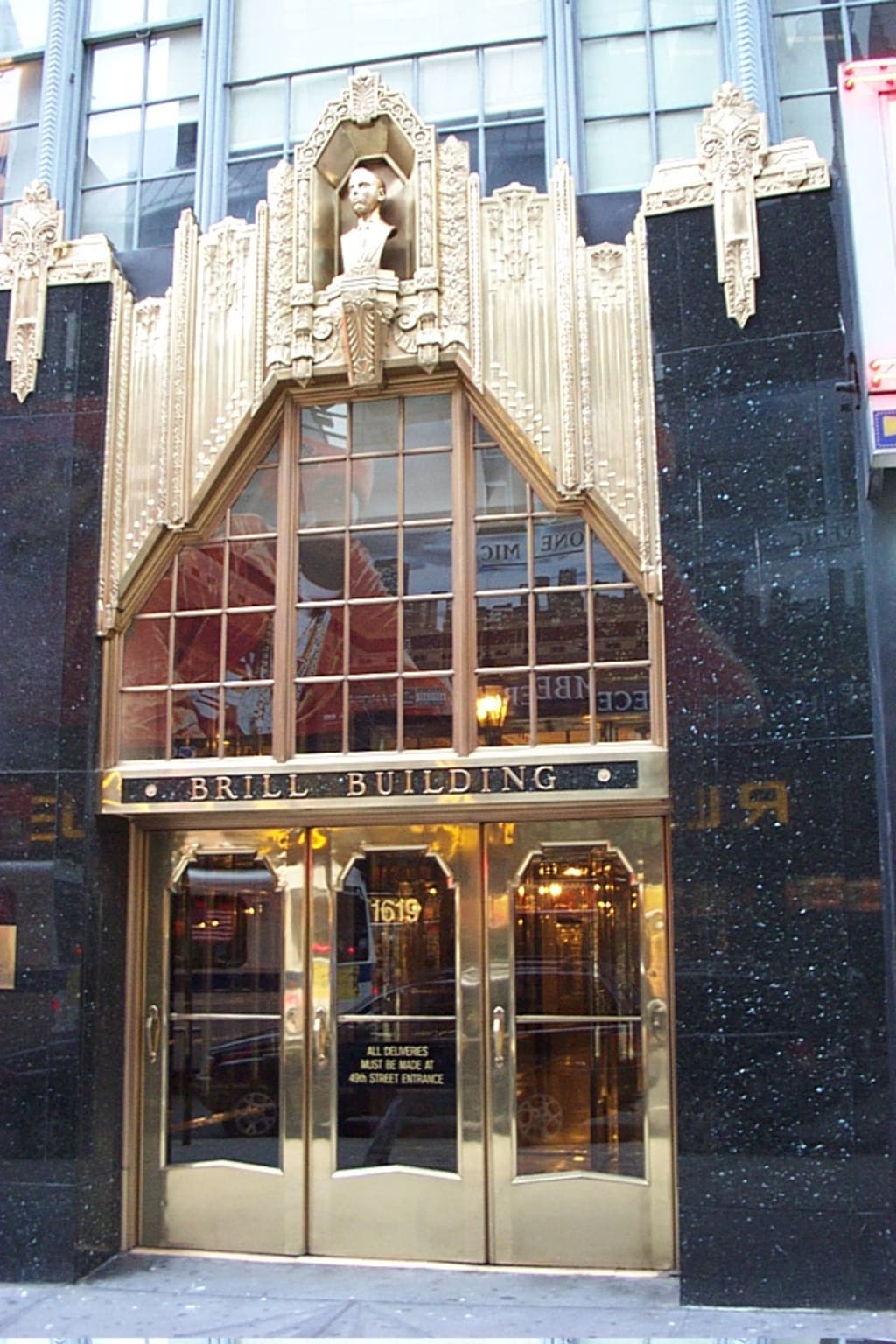The Brill Building
A Mecca for Songwriters

As a songwriter, one of the first places I had to go to when I moved to New York in 1999 was the Brill Building at Broadway and 49th Street. It was, quite simply, a pilgrimage of sorts to walk the sidewalks where the songwriting greats walked and created.
At 1619 Broadway, the Brill Building is just a little north of Times Square and a bit uptown from the historic Tin Pan Alley neighborhood.
Built in 1931, it was initially named the Alan E. Lefcourt Building after the son of its builder, Abraham E. Lefcourt, a prominent real estate developer in the 1920’s who was one of the most prolific developers of Art Deco buildings in New York City. The building is 11 stories high and is approximately 175,000 square feet.
The Brill Building Sound came out of a stretch along Broadway between 49th and 53rd streets. The Brill Building (named after the Brill Brothers clothing store) was located on the street level corner.
During the Depression, the owners were compelled to rent space to music publishers since there were few other businesses lining up to rent the space. The first three publishers in the Brill Building were Southern Music, Mills Music and Famous-Music and were quickly joined by others.
This led to the Brill Building becoming a center of activity for the popular music industry before Word World II, especially for publishing and songwriting in the Big Band era. Many music publishers had their offices in the Brill Building and as soon as the songs were published, they were sent to the popular bands and radio stations at the time. At this time, Brill Building songs were always at the top of Billboard’s Hit Parade and played by the leading bands of the day such as the Benny Goodman Orchestra, Glenn Miller Orchestra, Jimmy Dorsey Orchestra, and Tommy Dorsey Orchestra.
However, the Brill Building and it’s sound really reached its heyday in the 1950’s and 60’s when the building became famous for nurturing and making the careers of such famous writers and artists such as Burt Bacharach, Jeff Barry, Bobby Darin, Hal David, Carole King, Gerry Goffin, Laura Nyro, Neil Sedaka, Doc Pomus, and Johnny Mercer to just name a few.
A musician could find a publisher, printer, cut a demo, promote the record and cut a deal with promoters all within the same building. The creative culture at the Brill Building was literally off the charts (pun intended)!
Carole King described working in the Bill Building:
“Every day we squeezed into our respective cubby holes with just enough room for a piano, a bench, and maybe a chair for the lyricist if you were lucky. You’d sit there and write, and you could hear someone in the next cubby hole composing a song exactly like yours. The pressure in the Brill Building was really terrific because Donny (Kirshner) would play one songwriter against another. He’d say, “We need a new smash hit” and we’d all go back and write a song and the next day, we’d each audition for Bobby Vee’s producer.” - Quoted in The Sociology of Rock by Simon Frith
The Brill Building in the early '60s used the classic vertical integration business model. You could write a song and go around to the publishers in the building until someone bought the song. You could then go to another floor, get an arrangement and lead sheet for $10, book a studio, hire some musicians that were always hanging around, and cut a demo. Record companies, publishers, managers and artists were also located in the building, so you could easily make the rounds to pitch your work. And if you were fortunate enough to make a deal, there were promoters within walking distance also.
During this time, the Brill Building was considered the most prestigious address for music business professionals, and the term “Brill Building Sound” became almost synonymous for American popular music strongly influenced by Latin music, traditional Black Gospel and rhythm and blues that enjoyed such great commercial success in the 1950’s and 1960’s.
However, not everything was rosy in this atmosphere. The Brill Building approach was one of the ways professionals in the music industry took control of business in the time after the first wave of rock and roll. The artists/performers were not considered as important as the “hits” with artists being replaced right and left, especially if they proved unable to work within the system. Since “rock and roll” inherently breeds rebelliousness, many “difficult” artists were cut loose. Songs were written in almost an assembly line manner specifically to target teen audiences and any deviation was simply not tolerated. The Brill Building approach returned power to the publishers and record labels and made the performing artists nothing more than cogs which led to many artists and writers being taken advantage of financially.
For me, however, the magic of the Brill Building is, and always will be, the music and the writers whose work came out of this building. They literally wrote a playlist of my life. Many of these writer/producer teams wrote some of the biggest hits of the era.
Among of the hundreds of hits written by these writers were “Yakety Yak” (Leiber-Stoller), “Save the Last Dance for Me” (Pomus-Shuman), “The Look of Love” (Bacharach-David), “Breaking Up Is Hard to Do” (Sedaka-Greenfield), “Devil in Disguise” (Giant-Baum-Kay), “The Loco-Motion” (Goffin-King), “We Gotta Get Out of This Place (Mann-Weil”, and “River Deep, Mountain High” (Spector-Greenwich-Barry).
If you are a musician or a songwriter or just a fan, a visit to 1619 Broadway is a must!
- Julie O'Hara 2023
Thank you for reading my poem or article. Please feel free to subscribe to see more content and if you are moved to, please consider tipping. In addition, my books can be found at https: Julie O'Hara Bookshop
About the Creator
Julie O'Hara - Author, Poet and Spiritual Warrior
Thank you for reading my work. Feel free to contact me with your thoughts or if you want to chat. [email protected]






Comments
There are no comments for this story
Be the first to respond and start the conversation.